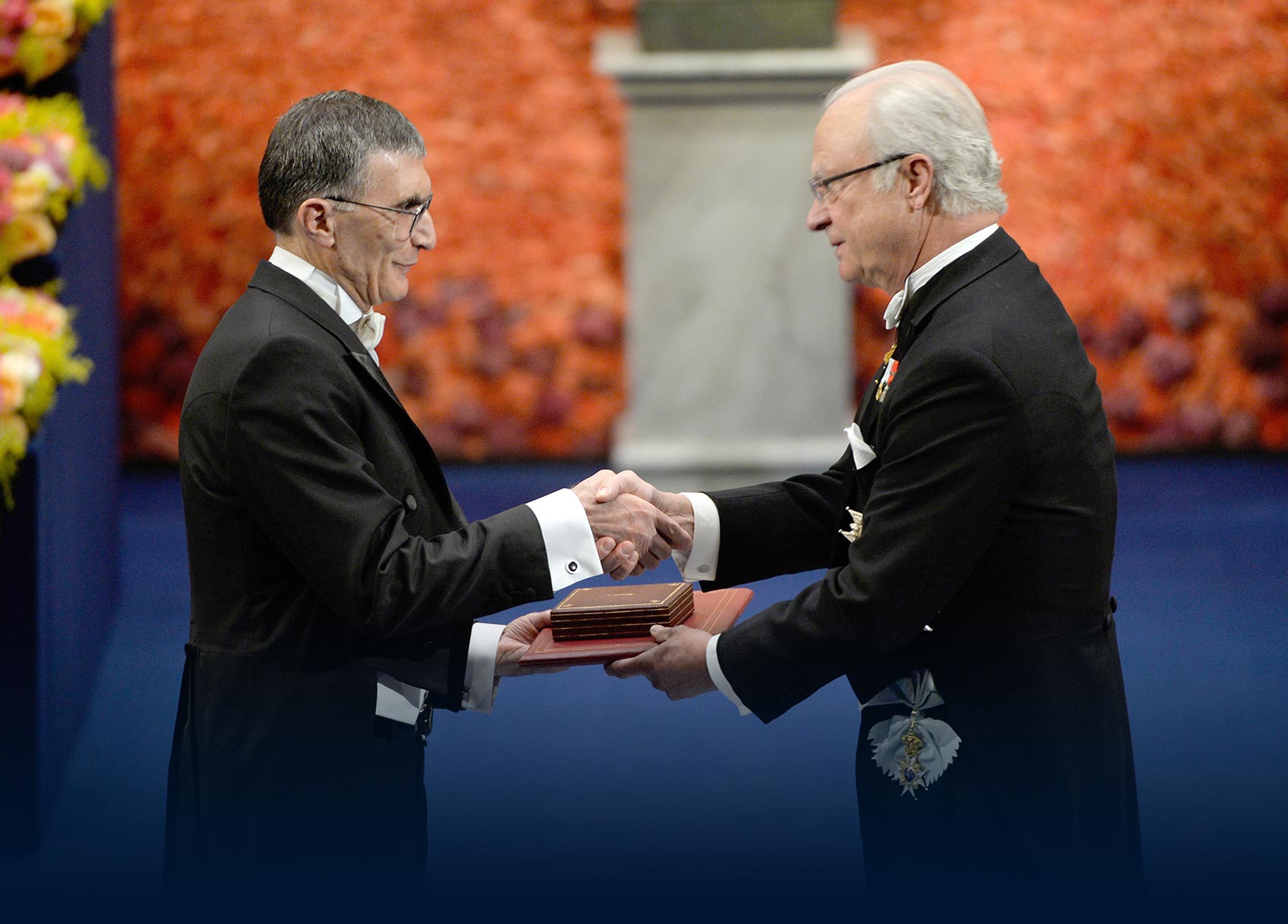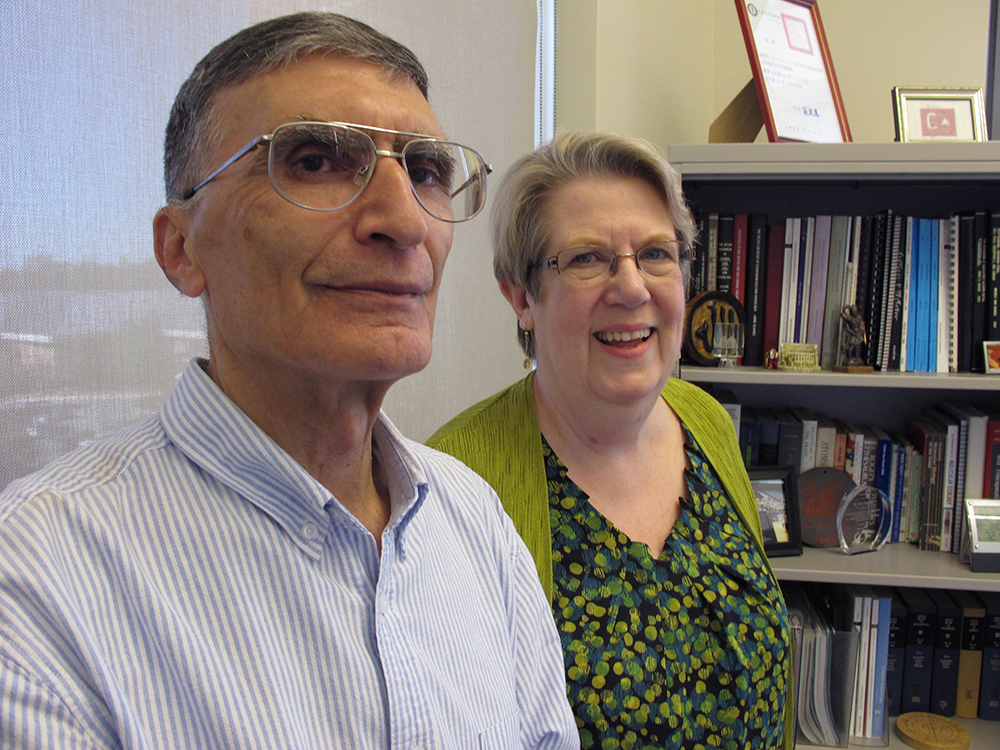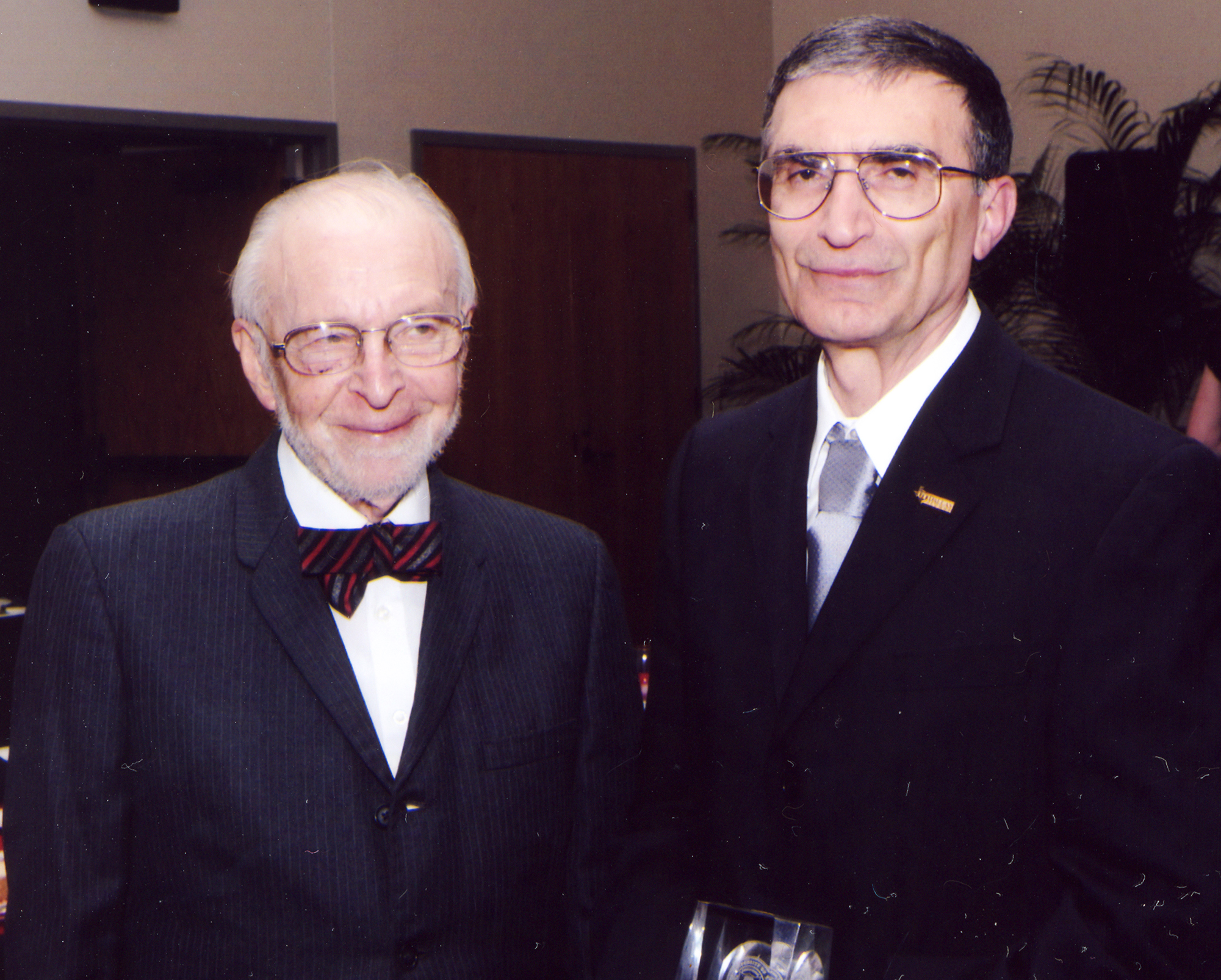
Aziz Sancar PhD’77 and Gwen Sancar MS’74, PhD’77
By Amanda Siegfried
Editors’ Note: This feature appears as it was published in the spring 2016 edition of UT Dallas Magazine. Titles or faculty members listed may have changed since that time.
Around 5 a.m. on Oct. 7, 2015, the phone rang at the home of Dr. Gwen Sancar MS’74, PhD’77 in Chapel Hill, North Carolina. She was just getting up to prepare for that day’s lecture at the University of North Carolina School of Medicine, where she is a professor of biochemistry and biophysics.
When she answered the phone, the woman on the line asked to speak to Gwen’s husband, Aziz, who was still asleep. She couldn’t tell Gwen what the call was about, only that it was an important call from Stockholm, home of the Royal Swedish Academy of Sciences.
“So I woke up Aziz and said, ‘It’s Stockholm!’ He said, ‘No way,’ and I said, ‘Yes way! Here, take the phone!’ ” Gwen recalled.
For the next 36 hours, no more sleep would come for Dr. Aziz Sancar PhD’77, the Sarah Graham Kenan Professor of Biochemistry and Biophysics at the UNC School of Medicine. It was a whirlwind, as he gave interviews and accepted congratulations from all over the world for being named one of the winners of the 2015 Nobel Prize in chemistry.
Aziz’s journey to reach that pinnacle of scientific achievement included a critical stop at the University of Texas at Dallas. As a graduate student here in the mid-1970s, Aziz Sancar (pronounced SAN-jar) began his Nobel Prize-winning research on DNA repair, mentored by one of the pioneers of the field, Dr. Claud Stanley Rupert, now a UT Dallas professor emeritus.
It was also here that Aziz met Gwen Boles, a Texas native and fellow PhD student in molecular biology. The two formed a friendship, talking (and
sometimes arguing) over laboratory equipment as they conducted delicate genetic research, and created a bond that would eventually lead the UT Dallas alumni to marriage and a partnership in science and service that has lasted nearly 40 years.
Genesis of Genius
Aziz grew up in a rural village in Turkey, one of eight children born to illiterate parents. His first career ambition was to become a soccer star for the Turkish national team, but Aziz ultimately decided to pursue science and medicine. He attended Istanbul Medical School and graduated at the top of his class.
After spending two years as a physician in rural Turkey, he returned to school, this time in the U.S., to learn more about the underlying mechanisms of disease. His first stop was Johns Hopkins University, where he was exposed to the then-novel field of DNA repair.
When Aziz learned that the scientist who had discovered DNA repair, Dr. Claud Stanley Rupert, had moved from Johns Hopkins to UT Dallas, he reached out.
“I knew I wanted to work on DNA repair, and I wanted to work with Dr. Rupert, so I contacted him,” Aziz said. “He gave me an ambiguous answer, so I just showed up at his lab and said, ‘You didn’t say no.’ ”
“That was Aziz,” Rupert said. “When he wanted to do something, he found ways of getting it done.”
Aziz said the intellectual climate at UT Dallas was “outstanding,” despite the fact that when he arrived in 1974, the University was not yet 10 years old.
That high-caliber scientific environment was generated years earlier, in UT Dallas’ precursor institution, the Graduate Research Center of the Southwest. Its founders — Erik Jonsson, Cecil Green and Eugene McDermott (who also created Texas Instruments) — recruited distinguished scientists from around the world to conduct fundamental research and provide graduate-level education in science and mathematics. Research focused on atmospheric and space sciences, geosciences, mathematics and mathematical physics, molecular science and genetics.
The institution became the University of Texas at Dallas in 1969, offering only graduate degrees at first before undergraduates were subsequently admitted.
“UT Dallas was the world center for DNA repair research,” Aziz said, “with at least five scientists working on different aspects. It was an extremely stimulating intellectual environment.”

The Sancars spoke with reporters following the Nobel Announcement in October.

The Sancars on their wedding day in 1978.
Foundations of Achievement
Nobel Prizes are awarded to individuals whose work confers the “greatest benefit to mankind,” according to the will of the prize’s founder, Alfred Nobel. The three recipients of the 2015 chemistry prize — Dr. Aziz Sancar, Dr. Tomas Lindahl and Dr. Paul Modrich — won for their individual efforts to map, at a molecular level, how cells repair damaged DNA and safeguard genetic information. Their work has applications in the development of new cancer treatments.
DNA is the genetic material in each of our cells that contains all the instructions for carrying out life’s functions. When it is exposed to damaging agents from the environment, such as cigarette smoke and ultraviolet light from the sun, those agents can cause changes to DNA called mutations, which are associated with many diseases, including cancer.

Aziz Sancar in a UT Dallas lab in the 1970s.
Like all organisms, human cells have processes to repair damage that is done to DNA. When those repair processes go wrong, additional disease-causing mutations can occur.
At UT Dallas, Aziz’s work focused on DNA repair in a bacterium, partly because in the 1970s, bacteria provided a much simpler experimental system than other organisms. As his PhD advisor and mentor, Rupert suggested that Aziz try to clone a gene for an enzyme called photolyase, which Rupert had been “playing” with, as the elder scientist described it. The enzyme repairs a cell’s DNA that has been damaged by ultraviolet light.
“He worked tremendous hours,” Rupert said. “He probably worked 90 hours a week. Nothing else existed but his work. If he wasn’t in the lab, he was in the library reading journals.”
Aziz successfully cloned that gene, and was the first to purify and describe the bacterial enzyme photolyase. Cloning the gene was a painstaking achievement that today is a common occurrence in the lab.
“Research methods and technologies have changed a lot,” said Aziz, who went on to study DNA repair in mammalian cells. “When I was at
UTD, it took me a year to clone a gene. Now, a first graduate student can clone a gene in two days.”
Aziz said his time at UT Dallas heavily influenced his subsequent research achievements and career.
“It was the foundation of everything I have done since,” he said. “I started on DNA repair at UT Dallas, and I have continued for over 40 years on that path. e University has had a significant impact on my research.”
Having a student of Aziz’s caliber working in the lab raised everybody’s game, Rupert said.
“I never had a student like him. He’s my masterpiece, so to speak, except I didn’t do [the work], he did it. He’s the guy who put in the hours and just would not stop until he had it just the way he wanted it. It was a great experience to have him in the lab.”
Gwen Sancar watches as Aziz Sancar writes his name in the Nobel Foundation’s guest book that has been signed by the laureates since 1952.
Partnership
Working long hours in a UT Dallas lab certainly paid off scientifically for Aziz, but it had other life-changing ramifications as well.
Gwen Boles came to UT Dallas to pursue graduate studies aer earning a bachelor’s degree in biology from Baylor University in her hometown of Waco, Texas. She grew up in a working-class family, where her mother — who started as a secretary and became vice president of an insurance company — stressed the importance of education.
Unlike Aziz, Gwen had a passion for science from an early age, encouraged by the women in her life.
“I knew when I was 6 years old that I wanted to be a scientist,” she said. “at was in part because my mom did some basic laboratory tests for the insurance company at that time, and on Saturdays I would go with her to the little lab.” Also, Gwen’s aunt had a master’s degree in chemistry and an independent lifestyle she admired.
As an undergraduate, Gwen conducted research for two summers at Emory University in Atlanta. There she first heard about a new university that
had opened in Richardson, Texas — ironically, just a Texas-sized stone’s throw from her hometown. Several Emory professors had left to teach there.
Based on what she heard and wanting to stay in Texas for graduate school in molecular biology, she chose to attend UT Dallas. Her research focused on DNA replication in eukaryotes, which are organisms such as plants and animals, as opposed to Aziz’s graduate research on prokaryotes — single- celled organisms, like bacteria.
“Aziz and I were both very hard-working grad students, and two of the few who tended to work very late in the lab, so we would meet in the evenings over equipment, basically,” Gwen said. “We talked with each other at night because there wasn’t anybody else to talk to while we waited for things to happen with our experiments.”
“Once she got angry at me because I was hogging some equipment,” Aziz recalled. “We argued over it a little bit, but then we became very good friends.”
With so much time and effort devoted to their graduate research and studies, the couple didn’t have much of a social life.
“Other than watching the Dallas Cowboys,” Aziz said. “I’ve been a fan of the Dallas Cowboys ever since the Hail Mary pass,” referring to the
game-winning desperation toss by quarterback Roger Staubach in a 1975 NFL playoff game.
The combination of their American and Turkish backgrounds — and the differences between them — made their relationship interesting, Gwen said.
“The more I learned about Turkey from him, the more fascinated I was by it. I wouldn’t say we didn’t have cultural differences, but we were
both understanding and worked it out.”
 Dr. Claud Stanley Rupert and Dr. Aziz Sancar.
Dr. Claud Stanley Rupert and Dr. Aziz Sancar.The couple’s parents were accepting, Gwen said, and Aziz’s mother was especially helpful. “His mother was basically a peasant woman from Turkey, and a devout Muslim, but she believed that everyone should be taken on their own merits and was equal in the sight of God,” Gwen said. “When I went to Turkey the first time, she made it very clear to the rest of his family that as long as I made her son happy, she was happy. That
led the way for the rest of the family and their attitudes, which helped a lot.”
The couple was married in Waco in 1978. After taking separate research positions in New York and at Yale School of Medicine, they both joined
the UNC medical school faculty in 1982. Aziz received the UT Dallas Distinguished Alumnus Award in 2009.
Building Bridges
Several years ago, the couple established the Aziz and Gwen Sancar Foundation to help promote closer ties between the U.S. and Turkey. Recognizing the need to help Turkish students adapt and transition to American culture, the couple established the Carolina Turk Evi, or Turkish House, in Chapel Hill. The house has four rooms for rent for Turkish graduate students and visiting scholars, and it’s a hub for activities aimed at educating the community about Turks and Turkey.
Turk Evi offers Turkish cooking classes, celebrates Turkish holidays, and hosts middle and high school teachers to help prepare them for
summer experiences in Turkey. The foundation also works with other organizations to help fund schools and libraries in underdeveloped areas of
Turkey and to assist recovery efforts during natural disasters.”
“It’s our way of giving back to Turkey,” Gwen said, “but also our way to help build better relations between Turkey and the U.S. at the grassroots level.”
Coming Full Circle
Back on that October day, as the news began to sink in after the early-morning wake-up call from Stockholm, the first call Aziz made was to the couple’s goddaughter.
The second number he dialed — at still an early hour — was that of his beloved mentor.
“I was delighted” to get the call, Rupert said. “He deserves good things. He’s a wonderful man. He takes good care of his students and he’s generous in giving credit to people.
“I feel like my own career is crowned by this. If I’ve done any good science at all, it’s getting Aziz his PhD, and getting him on his way.”



